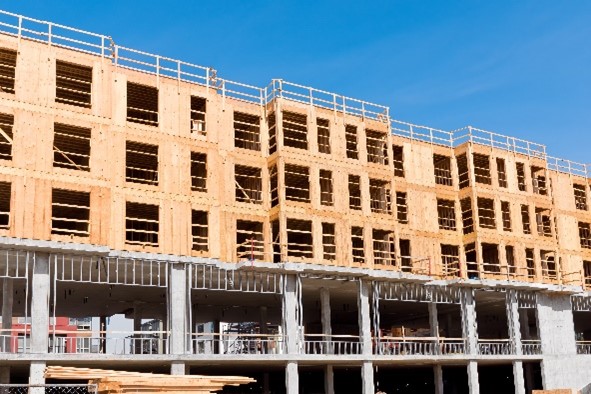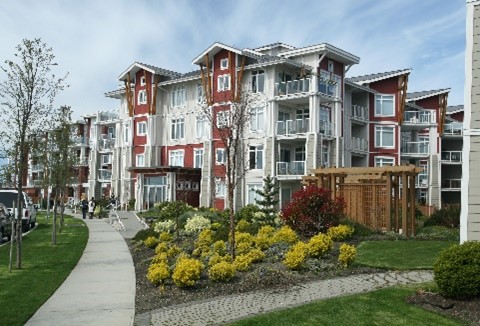Amidst challenges such as inflation, strict lending practices, and liquidity stress, the sector’s short-term returns and outlook remain in question. However, current optimism lies in high-demand assets in fast-growing metropolitan areas, presenting investment opportunities for some. While national asking rents in the U.S. have experienced a slight decline, regional variations emerge, calling for cautious monitoring of economic indicators in the sector moving forward. Multifamily REITs are showing adaptability and resilience after a cooling-off period, with rental rate growth stabilizing. As property taxes soar in various metros, managing expenses and net operating income becomes crucial for investors seeking long-term growth in their multifamily portfolios.
Multifamily Real Estate Navigating Short-Term Hurdles

Beneath the Seemingly Gloomy Outlook Lies Resilience
As the multifamily real estate market approaches the midpoint of the year, it is evident that the sector has encountered its fair share of obstacles. A combination of inflation, strict lending practices, and liquidity stress has led to dealmaking and development difficulties, putting a damper on short-term returns. However, beneath this seemingly gloomy outlook lies a resilient industry with the potential for long-term gains.
Navigating Short-Term Hurdles
It’s essential to acknowledge the persistent stresses currently affecting the multifamily market. Recent interest rate hikes by the Federal Reserve have raised concerns about a potential mild to moderate recession by year-end or early next year. The impact of slowing rent growth is evident, with “weak” growth rates observed at just 1.8 percent year-over-year, causing decreased returns for investors compared to earlier in 2023.
Transaction volumes within most metros have stagnated, driven primarily by historically high interest rates. This has led to a decrease in asset values, triggering a bid-ask spread and creating liquidity issues for owners and investors. Additionally, challenges securing construction loans have contributed to a supply shortage, making it difficult to meet housing demand adequately.
Turning Challenges into Opportunities
Despite these challenges, multifamily industry experts see reasons for optimism. Resilience is found in stabilized, high-demand assets located in fast-growing metropolitan areas, which are projected to outperform other segments in the market. Furthermore, regional banks’ pause on lending has created an opportunity for institutional investors and debt funds to adopt a more “holistic” approach to assess potential investments. This approach involves evaluating an asset’s short-term cash flow alongside value-add prospects, demographic projections, and long-term capitalizations.
High-demand sectors, such as build-to-rent, student housing, and workforce housing, present attractive investment opportunities. Cities experiencing high migration and limited supply offer particular promise, given the widespread housing shortage that is driving rent growth and regulatory pressures in certain jurisdictions.
Long-Term Resilience
Amidst the current challenges, the multifamily sector remains structurally sound, unlike some other real estate segments such as office and retail. While there may be periods of stress, the industry is not going through a fundamental change that would jeopardize its long-term prospects. This outlook contrasts sharply with the uncertainties faced by the office and retail sector.
Cap rates matching interest rates, ideally with a decrease in the federal funds rate, are key indicators of a prosperous investment environment. Though the road ahead may have its twists and turns, experts agree that finding the right balance between cap rates and interest rates will pave the way for growth and bridge any short-term gaps.
Long-Term Resilience and Growth Potential Shine Through
The multifamily real estate market stands at a crossroads, facing both challenges and opportunities. While short-term losses and obstacles are evident, long-term resilience and growth potential shine through. As the industry evolves, investors who strategically navigate the current hurdles, embrace high-demand sectors, and keep an eye on long-term prospects stand to reap the rewards of a dynamic and ever-adapting multifamily market. By understanding the nuances of each market and adopting a forward-thinking approach, multifamily investors can position themselves for success, turning challenges into triumphs and uncertainty into stability.
Asking Rent Declines and Emerging Opportunities

National Asking Rents Experience Slight Decline
In a surprising turn of events, national asking rents in the U.S. have experienced a slight decline for the first time since early 2021, signaling a shift in the multifamily rental market. Though a 1% drop in rent may appear modest at first glance, the context in which it occurs is crucial. During 2021, the rental market witnessed an unprecedented surge, with rent growth soaring to around 17%. The recent decline is, therefore, more significant than it seems, leaving multifamily investors wondering about the implications and the way forward.
Understanding Regional Dynamics
In the West and select parts of the South, rents have dropped more noticeably. On the other hand, in the Northeast and Midwest, rents are still on the rise, albeit at a slower pace. Several factors contribute to these regional differences.
In the Northeast, the strong job market has sustained rent growth. As employment opportunities continue to flourish, demand for rental properties remains robust. In the Midwest, rents are relatively affordable, allowing for further growth potential. However, these regions face unique challenges, with certain areas experiencing rents reaching long-term highs, leading to concerns about affordability and slowing rent growth.
The Supply and Demand Dynamic
One reason behind the overall rent decline and regional variations lies in the supply and demand balance. The surge in rent growth experienced in recent years has prompted a response from the market. More housing supply is now becoming available, providing tenants with additional choices and putting downward pressure on rents.
However, it is essential to approach this trend with cautious optimism. The surge in supply could be short-lived, as builders face challenges in obtaining financing due, in part, to the Federal Reserve’s interest rate hikes. These economic factors may dampen the enthusiasm for further investment in rental properties and limit the growth in housing supply.
Navigating the Multifamily Rental Market
As multifamily investors navigate this evolving rental landscape, strategic considerations become paramount. While the recent rent decline may offer some relief to renters, it is equally critical to anticipate potential future changes.
The rental market remains dynamic, and investors should closely monitor economic indicators, such as job market trends, interest rates, and affordability measures, to make informed decisions. Embracing innovative strategies, and targeted geographic locations, can also offer a competitive advantage in the multifamily sector.
Market Experiencing a Notable Shift
The multifamily rental market is experiencing a notable shift, with rents showing a slight national decline after a period of unprecedented growth. As regional variations emerge, multifamily investors must analyze market dynamics and economic indicators to make well-informed decisions. While an increase in housing supply has contributed to the recent rent decline, potential financing challenges for builders may impact future supply levels.
The Resilience of Multifamily REITs in a Shifting Rental Market

REITS Becomoing More Opportunistic on Multifamily
The multifamily rental market has undergone a significant transformation in recent times, and multifamily REITs are showing signs of adaptability and resilience. After a period of cooling-off in 2022, these REITs are becoming opportunistic once again. Several fundamental changes have reinvigorated the outlook for this sector.
The Changing Landscape of Investment
The year 2022 was marked by harsh price movements in apartment REITs, with the sector experiencing a sharp decline of around 30% from its peak. This decline significantly impacted Funds From Operations (FFO) multiples, reducing them from about 30X to approximately 18X today. While 18X may not seem remarkably cheap, it is reasonable for a growth sector like multifamily REITs. However, it is crucial to recognize that this is just a part of the investment landscape, and there is potential for even cheaper multiples if investors choose wisely within the sector.
Supply and Demand Dynamics
One of the primary reasons for the drastic price decline was the market’s fear of a wave of apartment construction, with the greatest influx of new supply since the 1970s. While the concerns are valid, they overshadow crucial mitigating factors that are being overlooked.
Construction durations have been extended due to labor shortages, red tape, and financing delays, leading to an exaggerated number of units under construction. This surplus of construction is occurring in a market that was historically undersupplied, resulting in unsustainably high occupancy levels.
Strong net absorption, starting in 2Q23, has played a significant role in absorbing the new units while maintaining healthy occupancy levels.
The market tends to extrapolate trends, resulting in pricing in further declines in occupancy and rent growth. However, a longer view of historical data reveals that the adjustments are merely restoring equilibrium.
The Path to Normalization
Rental rates experienced an astoundingly high growth of around 15% in 2022, causing concerns about a potential downturn. However, this growth was an anomaly and should be viewed in perspective. The drop in rental rates is more a restoration of equilibrium than a sign of impending decline.
The most likely path forward is moderate rental rate growth in the range of 1%-2% until the remaining 2023 deliveries are completed. Thereafter, rental rate growth is expected to rebound to historical averages of 3%-4%.
Selecting the Right Opportunities
The multifamily rental market offers a range of opportunities for investors. Among the REITs, those operating in the sunbelt regions stand out as particularly appealing. Camden and Elme Communities, with their focus on the sunbelt and Washington D.C., respectively, show better affordability, absorption of demand, and long-term demand drivers. Additionally, NexPoint’s emphasis on class B apartments offers potential for increased rental rates.
The Outlook and Timing
With supply and demand normalizing, the multifamily market is moving toward a comfortable equilibrium. Investors can expect moderate rental rate growth, leading to mid-single-digit FFO/share growth for apartment REITs. Though not wildly opportunistic, this growth rate, coupled with the sector’s significantly higher dividend yield, offers a reasonable investment prospect.
Timing considerations are crucial, as market share prices are not likely to experience a sharp rebound until rental rates accelerate. Equilibrium restoration is expected in 2023 and 2024, with rental rate growth likely to return to normal levels by mid-2024, reinvigorating market interest in apartment REITs.
Poised for Resurgence
The multifamily rental market is poised for a resurgence, and multifamily REITs are emerging as opportunistic investment options. The sector’s resilience and adaptability are evident in the face of recent challenges. Investors should carefully consider regional dynamics, supply and demand factors, and long-term demand drivers while selecting investment opportunities. With careful planning and a long-term approach, investors can unlock the potential of multifamily REITs and benefit from the evolving rental market.
Understanding Multifamily Property Tax Challenges

Property Taxes Soar in Some Metros
Multifamily owners and operators are facing a growing concern as property taxes soar in many metros, outpacing inflation rates. A recent report by Trepp sheds light on the escalating property tax burden and its potential impact on net operating income. As inflation eases, other regular expenses, such as rising insurance costs due to climate change-driven natural disasters, continue to strain multifamily properties.
The Surge in Property Taxes
In the multifamily industry, property tax growth has always been a part of regular operating expenses, but the recent pace of growth in many metros is far higher than recent peak inflation rates. Between 2021 and 2022, the top five metros with the highest year-over-year property tax increases were Richmond, VA (15.3%); Orlando-Kissimmee-Sanford, FL (12.2%); Salt Lake City, UT (11.9%); Virginia Beach-Norfolk-Newport News, VA-NC (10.9%); and Chicago-Naperville-Elgin, IL-IN-WI (9.9%).
Factors Driving Property Tax Increases
- Population Shifts and Rising Property Values
- Some metros, like Richmond, VA, experienced significant population shifts as residents relocated due to the increased cost of living in Northern Virginia. Demand for housing drove up property values, leading to higher assessed values and taxes.
- High Demand for Apartments
- Salt Lake City witnessed a surge in demand for apartments, resulting in higher property prices. The overall commercial real estate (CRE) values grew at 11.8%, and the city council approved a 4.9% property tax increase, the first since 2014.
- Impact on Net Operating Income
- As property taxes continue to rise, multifamily owners and operators may face challenges in maintaining a healthy net operating income. The strain on net operating income could affect debt service coverage ratios, making lenders more cautious about financing or refinancing properties in the future.
Grappling with Significant Increases in Property Taxes
The multifamily sector is grappling with a significant increase in property taxes in various metros across the country. As property taxes continue to rise, it becomes crucial for investors to carefully manage expenses and ensure the expenses are kept in check. Being aware of property tax increases and the factors causing those increases will help investors proactively navigate this challenge and secure long-term growth in their multifamily portfolios.
Excelsa Properties Acquires Concord Park at Russett Multifamily Property
Excelsa Properties Acquired Concord Park at Russett
Excelsa Properties, in partnership with its U.S. Real Estate II fund and an Excelsa co-investment vehicle, has recently acquired Concord Park at Russett, a 335-unit multifamily property in Laurel, Maryland, for $105.5 million. The property was sold by Starwood Capital Group, who purchased it in 2019. The acquisition is part of Excelsa’s strategy to invest in U.S. multifamily properties, having acquired $600 million worth of such assets in the last three years.
Location and Amenities
Concord Park at Russett is strategically located in the sixth-largest national metropolitan statistical area (MSA), providing excellent connectivity to major job centers. The property boasts large institutional assets with spacious floor plans and resort-style amenities, making it an attractive destination for potential residents.
Assumable Debt
One of the key highlights of this acquisition is the assumption of an existing interest-only loan with a fixed rate of 3.4 percent, complemented by a new fixed-rate interest-only loan of a similar maturity date with a weighted average interest rate of 3.7 percent. The assumable debt is valued at less than $62 million, making it an appealing aspect of the deal.
Planned Upgrades
Excelsa Properties plans to invest $4.4 million in property upgrades. The planned improvements include adding a new roof, HVAC system, and signage, as well as repairing parking decks and installing stainless-steel appliances, hardwood flooring, and tech packages. These enhancements aim to further enhance the property’s appeal to potential tenants.
Demographic and Market Overview
Concord Park at Russett is situated in Anne Arundel County, which has a population of approximately 600,000 residents and 90,000 employees. The property’s prime location provides easy access to the entire Baltimore-Washington area, making it an attractive destination for renters.


